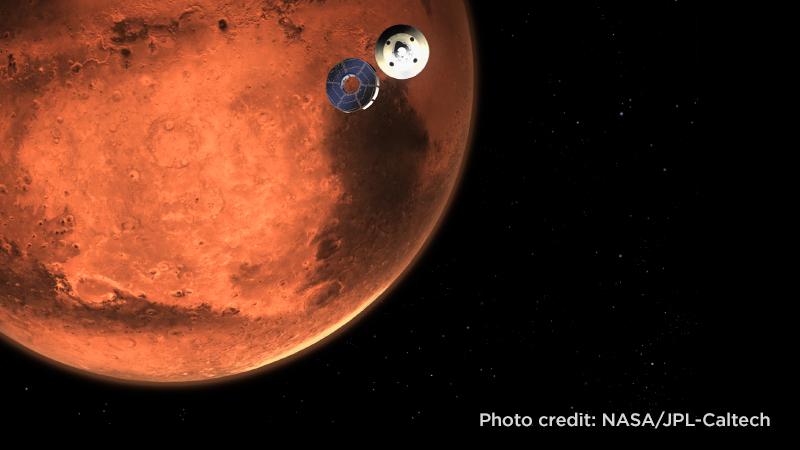The Red Planet is in sight – FMI and Vaisala’s scientific measurement instruments onboard Mars rover are ready for action
Finnish Meteorological Institute and Vaisala
Press Release
February 15, 2021
The Red Planet is in sight – FMI and Vaisala’s scientific measurement instruments onboard Mars rover are ready for action
NASA’s Perseverance rover, launched in July 2020, is landing on Mars on February 18. The Perseverance is carrying several scientific instruments on board, including Finnish-made humidity and pressure instrumentation.
All eyes will be on the sky with the Perseverance rover scheduled to land on Mars on February 18. The Finnish Meteorological Institute (FMI) has provided Perseverance with measurement instrumentation. Equipped with Vaisala’s sensors, FMI’s instrumentation will be used to provide accurate and reliable pressure and humidity measurements in the extreme conditions of Mars.
On a quest to find answers
Landing on Mars is a thrilling moment. The true test of success, however, will be the entire mission as the rover operates in the Red Planet’s extreme conditions. Perseverance will spend at least one Mars year, equal to around two Earth years, exploring the landing-site area.
The rover is expected to land on the ancient river delta in Jezero Crater, which is the optimal place to find traces of ancient life. To collect data and samples from the Red Planet, NASA is working together with a group of trusted scientific partners.
The FMI’s instrumentation is part of the Spanish-led consortium’s Mars Environmental Dynamics Analyzer (MEDA). The MEDA instrumentation kit is basically a Martian weather station that takes a wide range of atmospheric measurements: temperature, wind speed and direction, pressure, relative humidity, and the amount and size of dust particles. Vaisala’s pressure and humidity sensors onboard Perseverance are similar, but more advanced, to the ones sent to Mars on the Curiosity rover in 2012.
“The rover’s equipment needs to operate in the harsh Martian environment, with very low pressure conditions and cold temperatures, and it must be able to resist possible global dust storms. In addition to the environmental aspects and potential dangers of the landing itself, the distance between Mars and Earth makes the mission challenging. There is no one to fix the instrumentation if something goes wrong,” says Maria Genzer, Head of Planetary Research and Space Technology Group at FMI.
Meteorological observation network on another planet
When landing, the Perseverance and Mars Science Laboratory (MSL) Curiosity will operate around 2000 km from each other. Together they help creating a small-scale atmospheric observation network on Mars. It is the first step towards the wider observation network being planned for Mars in the future.
“Mars and Earth are like rocky sisters. They both have seasonal variation, ice caps, similar declination of axis, length of day, and rocky consistency. Mars offers us a basic model of Earth – without vegetation, water, human life, cities, and other ‘noise’ we encounter on Earth,” says Genzer. “Interplanetary atmospheric research offers us tools to better understand our current habitat. And who knows what other findings there might be.”
“We are excited to provide our world-leading sensor technology to a Mars mission once again. Our accurate and durable HUMICAP® and BAROCAP® sensors will enable high-quality humidity and pressure data even on the Red Planet and lay the foundations for the atmospheric observation network on Mars,” says Samuli Hänninen, Vice President of Vaisala’s Products and Technologies.
The Mars 2020 mission is part of NASA’s Mars Exploration Program. The Perseverance rover is designed to better understand the environmental conditions and geology of Mars and seek signs of ancient life. The mission will collect and store a set of rock and soil samples that could be returned to Earth in the future.
Learn more about our space exploration and space-proof technology by visiting vaisala.com/space.
More information for the media:
Maria Genzer, Head of Planetary Research and Space Technology Group, Finnish Meteorological Institute
+358 29 539 4724, [email protected]
Maria Hieta, Research Engineer, Finnish Meteorological Institute
+358 29 539 2063, [email protected]
Tiina Ervasti, Communications Specialist, Finnish Meteorological Institute
+ 358 29 539 3501, [email protected]
Miia Lahti, Communications Manager, Vaisala
+358 50 555 4420, [email protected]
The Finnish Meteorological Institute is a research and service agency under the Ministry of Transport and Communications in Finland. Its mission is to produce high-quality observation and research data on the atmosphere and seas. The Institute combines this expertise into the weather, climate and oceanographic services it provides to promote public safety as well as increase well-being in the society and the environment, taking into account the needs to maintain preparedness. More information about FMI in space: https://space.fmi.fi, linkedin.com/finnish-meteorological-institute
Vaisala is a global leader in weather, environmental, and industrial measurements. Building on over 80 years of experience, Vaisala provides observations for a better world, with space-proof technology even exploring Mars and beyond. We are a reliable partner for customers around the world, offering a comprehensive range of innovative observation and measurement products and services. Headquartered in Finland, Vaisala employs over 1,900 professionals worldwide and is listed on the Nasdaq Helsinki stock exchange. vaisala.com/space, twitter.com/VaisalaGroup, linkedin.com/vaisala
Attachment
